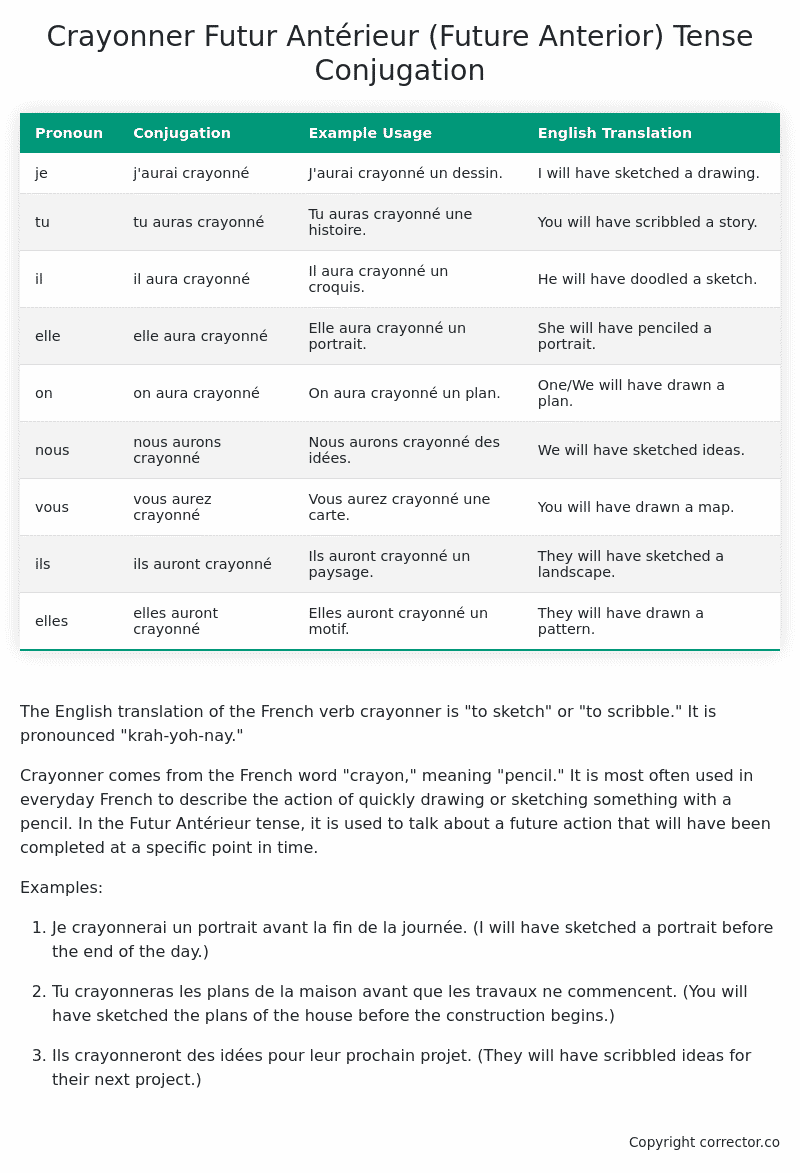Futur Antérieur (Future Anterior) Tense Conjugation of the French Verb crayonner
Introduction to the verb crayonner
The English translation of the French verb crayonner is “to sketch” or “to scribble.” It is pronounced “krah-yoh-nay.”
Crayonner comes from the French word “crayon,” meaning “pencil.” It is most often used in everyday French to describe the action of quickly drawing or sketching something with a pencil. In the Futur Antérieur tense, it is used to talk about a future action that will have been completed at a specific point in time.
Examples:
-
Je crayonnerai un portrait avant la fin de la journée. (I will have sketched a portrait before the end of the day.)
-
Tu crayonneras les plans de la maison avant que les travaux ne commencent. (You will have sketched the plans of the house before the construction begins.)
-
Ils crayonneront des idées pour leur prochain projet. (They will have scribbled ideas for their next project.)
Table of the Futur Antérieur (Future Anterior) Tense Conjugation of crayonner
| Pronoun | Conjugation | Example Usage | English Translation |
|---|---|---|---|
| je | j’aurai crayonné | J’aurai crayonné un dessin. | I will have sketched a drawing. |
| tu | tu auras crayonné | Tu auras crayonné une histoire. | You will have scribbled a story. |
| il | il aura crayonné | Il aura crayonné un croquis. | He will have doodled a sketch. |
| elle | elle aura crayonné | Elle aura crayonné un portrait. | She will have penciled a portrait. |
| on | on aura crayonné | On aura crayonné un plan. | One/We will have drawn a plan. |
| nous | nous aurons crayonné | Nous aurons crayonné des idées. | We will have sketched ideas. |
| vous | vous aurez crayonné | Vous aurez crayonné une carte. | You will have drawn a map. |
| ils | ils auront crayonné | Ils auront crayonné un paysage. | They will have sketched a landscape. |
| elles | elles auront crayonné | Elles auront crayonné un motif. | They will have drawn a pattern. |
Other Conjugations for Crayonner.
Le Present (Present Tense) Conjugation of the French Verb crayonner
Imparfait (Imperfect) Tense Conjugation of the French Verb crayonner
Passé Simple (Simple Past) Tense Conjugation of the French Verb crayonner
Passé Composé (Present Perfect) Tense Conjugation of the French Verb crayonner
Futur Simple (Simple Future) Tense Conjugation of the French Verb crayonner
Futur Proche (Near Future) Tense Conjugation of the French Verb crayonner
Plus-que-parfait (Pluperfect) Tense Conjugation of the French Verb crayonner
Passé Antérieur (Past Anterior) Tense Conjugation of the French Verb crayonner
Futur Antérieur (Future Anterior) Tense Conjugation of the French Verb crayonner (this article)
Subjonctif Présent (Subjunctive Present) Tense Conjugation of the French Verb crayonner
Subjonctif Passé (Subjunctive Past) Tense Conjugation of the French Verb crayonner
Subjonctif Imparfait (Subjunctive Imperfect) Tense Conjugation of the French Verb crayonner
Subjonctif Plus-que-parfait (Subjunctive Pluperfect) Tense Conjugation of the French Verb crayonner
Conditionnel Présent (Conditional Present) Tense Conjugation of the French Verb crayonner
Conditionnel Passé (Conditional Past) Tense Conjugation of the French Verb crayonner
L’impératif Présent (Imperative Present) Tense Conjugation of the French Verb crayonner
L’infinitif Présent (Infinitive Present) Tense Conjugation of the French Verb crayonner
Struggling with French verbs or the language in general? Why not use our free French Grammar Checker – no registration required!
Get a FREE Download Study Sheet of this Conjugation 🔥
Simply right click the image below, click “save image” and get your free reference for the crayonner Futur Antérieur tense conjugation!

Crayonner – About the French Futur Antérieur (Future Anterior) Tense
Construction
Common Everyday Usage Patterns
Interactions with Other Tenses
For example
Summary
I hope you enjoyed this article on the verb crayonner. Still in a learning mood? Check out another TOTALLY random French verb conjugation!


